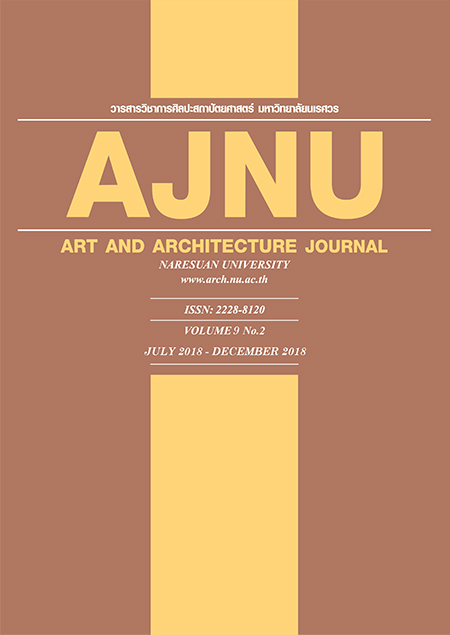ที่ว่างกึ่งบวกกึ่งลบ : ที่ว่างสื่อกลางระหว่างมนุษย์ สถาปัตยกรรมและบริบท
Main Article Content
บทคัดย่อ
เมื่อเราแบ่งที่ว่างทางสถาปัตยกรรมโดยใช้เจตจำนงเป็นเกณฑ์แล้วจะมีที่ว่างเกิดขึ้น 2 ประเภทได้แก่ ที่ว่างเชิงบวก
(Positive Space) ซึ่งเป็นที่ว่างที่มีการวางผัง มีการรองรับความต้องการใช้งาน และมีขอบเขตที่ชัดเจน และอีกประเภทคือที่ว่าง
เชิงลบ (Negative Space) ซึ่งเป็นที่ว่างถูกปล่อยปละ ไม่มีขอบเขต ไม่มีการใช้งานอันเฉพาะเจาะจงทางพื้นที่ ซึ่งได้แก่ที่ว่างทาง
ธรรมชาติ หรือบริบทรอบนอกที่ตั้งที่ไม่สามารถควบคุมได้ แต่ยังมีที่ว่างอีกประเภทหนึ่งซึ่งเป็นที่ว่างสื่อกลางระหว่างที่ว่างสอง
ประเภทข้างต้น เป็นที่ว่างที่เปิดโอกาสให้ที่ว่างทั้งสองประเภทข้างต้นไหลแทรกซึมสู่กัน จนเกิดเป็นการเชื่อมต่อระหว่างกัน ที่ว่าง
ดังกล่าวคือที่ว่างกึ่งบวกกึ่งลบ (Positive/Negative Space) ซึ่งทำหน้าที่เป็นที่ว่างสื่อกลางหนึ่ง ที่ว่างกึ่งบวกกึ่งลบนั้นถูกเริ่มต้น
อธิบายไว้โดยสถาปนิกชาวญี่ปุ่น Yoshinobu Ashihara ซึ่งแม้จะถูกเขียนไว้ในหนังสือ Exterior Design in Architecture ซึ่ง
เผยแพร่ไว้ตั้งแต่ปี ค.ศ. 1971 แต่กลับไม่ถูกสานต่อหรือเผยแพร่อย่างกว้างขวาง บทความนี้จึงมีวัตถุประสงค์ในการนำเสนอให้
เข้าใจถึงที่ว่างกึ่งบวกกึ่งลบ รวมไปถึงที่ว่างทางสถาปัตยกรรมประเภทต่างๆ ที่เกี่ยวข้องเพื่อให้เห็นถึงที่มา เงื่อนไข หน้าที่และ
คุณประโยชน์ของที่ว่างกี่งบวกกึ่งลบ ที่ว่างกึ่งบวกกึ่งลบนั้นมีสาระสำคัญในการช่วยให้เกิดความเชื่อมโยงเป็นสื่อกลางระหว่างที่
ว่างภายในอันเป็นที่ว่างทางสถาปัตยกรรมกับธรรมชาติภายนอกอันเป็นที่ว่างเชิงลบ จนเกิดเป็นการเชื่อมโยงระหว่างมนุษย์กับ
สภาพแวดล้อมภายนอก
Article Details
เอกสารอ้างอิง
Yoshinobu Ashihara. (1981). ”Positive and Negative Space” in Exterior design in architecture, 31-45, Van Nostrand Reinhold Company; Revised Edition.
Kengo Kuma.”Flowing Out” in Anti-Objet, 34-47, Architectural Association (October 30, 2013)
Steve Holl. ”Archetypal Experiences in Architecture” in Question in Perception, 124-127, William K Stout Pub; 2nd edition (July 15, 2007)
Teiji Itoh. Space and Illusion in the Japanese Garden, 29-32, Weatherhill; 3rd edition (September 1, 1980) Peter Schjeldahl. (June 2, 2003) The Prophet: Malevich’s Revolution. accessed October 25, 2017 ,from https://www.newyorker.com/magazine/2003/06/02/the-prophet-2
ทิพย์สุดา ปทุมานนท์. (2535). การจัดองค์ประกอบและที่ว่างในงานออกแบบพื้นฐาน , 47, กรุงเทพมหานคร: กราฟฟิค แอนด์ พับบลิเคชั่นส์.
อรศิริ ปาณินท์.(2538).ที่ว่างทางสถาปัตยกรรม. พิมพ์ครั้งที่ 2 (ปทุมธานี : โรงพิมพ์มหาวิทยาลัยรังสิต.
เจนยุทธ ล่อใจ. คุณลักษณะของที่ว่างทางสถาปัตยกรรมในสถาปัตยกรรมพื้นถิ่น: แนวทางการศึกษาสู่การออกแบบสถาปัตยกรรมร่วมสมัย, 66, วารสารวิชาการ การออกแบบสภาพแวดล้อม ปีที่ 2 ฉบับที่ 2 (กรกฎาคม –ธันวาคม 2558).
ต้นข้าว ปาณินท์. (2553. ) คนและความคิดทางสถาปัตยกรรม. สำนักพิมพ์สมมติ.


